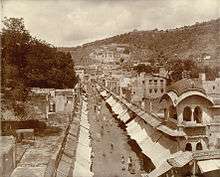History of Bundi
History of Bundi, now in the Rajasthan state of India.
In ancient times, the area around Bundi was apparently inhabited by various local tribes, of which the Parihar Meenas were prominent. Bundi and the eponymous princely state are said to derive their names from a former Meena king called Manan shrestha. Bundi was previously called “Bunda-Ka-Nal", Nal meaning “narrow ways”. Bundi is situated in a narrow valley within the Aravalli Hills in Rajasthan. Later the region was governed by Rao Deva Hada, who took over Bundi from Jaita Meena in 1342, renaming the surrounding area Haravati or Haroti.
Princely State
.jpg)


British era

In 1804 Rao Raja Bishan Singh (1773–1821) gave valuable assistance to Colonel Monson in his disastrous retreat before Holkar, in revenge for which the Maratha Empire and Pindaris continually ravaged his state and forced the kingdom to pay tribute up to 1817. Consequently, Bishan Singh made a subsidiary alliance with the British East India Company on 10 February 1818, which brought him under its protection. was responsible for the creation of the pleasure palace of Sukh Niwas on the outskirts of Bundi.
When dying of cholera, Bishan Singh entrusted James Tod with guardianship of his 11-year-old son, Ram Singh. Maharao Raja Ram Singh (1821–89) grew up to be a much respected ruler who initiated economic and administrative reforms and established schools for the teaching of Sanskrit. On the throne for 68 years, he was described as a grand specimen of the Rajput gentleman and "the most conservative prince in conservative Rajputana."[1] His rule was popular and beneficial; and though during the mutiny of 1857 his attitude was equivocal, he continued to enjoy the confidence of the British, being created G.C.S.I. and a counselor of the empire in 1877 and C.I.E. in 1878. He was succeeded by his adopted son Raghubir Singh (1889–1927), who was made a K.C.S.I. in 1897 and a G.C.I.E. in 1901. His reign was blighted by two disastrous famines. Despite his best efforts at alleviation, the population of his kingdom was reduced from some 258,000 to 171,000 by 1901 due to death and emigration.[1] Raghubir Singh supported the British during the World War I.
Maharao Bahadur Singh (1945–77) also supported the British and served in the Burma campaign, where he earned the Military Cross for his gallantry before succeeding to the throne. He was a guest at the 1947 wedding of Princess Elizabeth and Philip, Duke of Edinburgh. [2]
Accession to India
At the time of the partition of India in 1947, the British abandoned their suzerainty over the princely states, which were left to decide whether to remain independent or to accede to the newly independent Dominion of India or to Pakistan. The ruler of the state of Bundi decided to accede to India, which later became the Union of India. This brought the internal affairs of Bundi under the control of Delhi.
Rulers
The hereditary rulers of Bundi used the title ‘Rao’ before being granted the prefix ‘Raja’ by the Mughals. A Raja is a ruler of exalted rank but inferior to Maharana or Maharawal.
- Jaita Meena
- Rao Deva (1343 to 1342).
- Rao Napuji.
- Rao Hamuli (1384 to 1400).
- Rao Birsingh (1400 to 1415).
- Rao Biru (1415 to 1470).
- Rao Bandu (1470 to 1491).
- Rao Narayan Das (1491 to 1527).
- Rao Suraj Mal (1527 to 1531).
- Rao Surtan Singh (1531 to 1544).
- Rao Raja Surjan Singh (1544 to 1585).
- Rao Raja Bhoj Singh (1585 to 1608).
- Rao Raja Ratan Singh (1608 to 1632).
- Rao Raja Chhattar Sal Singh (1632 to 1658).
- Rao Raja Bhao Singh (1658 to1682).
- Rao Raja Anirudh Singh (1682 to 1696).
- Rao Raja Budh Singh (b. ... - d. 1739) (1696 to 1735).
- Rao Raja Dalel Singh (b. 1729 - d. 1804) (1735 to 1749).
- Rao Raja UMMED SINGH JI(1749 to 1770) and again (1773 to 1804).
- Rao Raja Ajit Singh (b. ... - d. 1773) (1770 to 1773).
- Rao Raja Bishen Singh (b. ... - d. 1821) (1804 to 14 May 1821).
- Maharao Raja Ram Singh Sahib Bahadur (b. 1811 - d. 1889) (1821 to 28 Mar 1889).
- Colonel HH Maharao Raja Shri Sir Raghubir Singh Sahib Bahadur (b. 1869 - d. 1927) (12 April 1889 to 28 Jul 1927).
- Major HH Maharao Raja Shri Sir Iishwari Singh Bahadur (b. 1893 - d. 1945) (8 Aug 1927 to 3 Apr 1945).
- Col. HH Maharao Raja Shri Bahadur Singh Bahadur (b. 1920 - d. 1977) (1945 to 1977).
- HH Maharao Raja Ranjit Singh (1977 to 07-01-2010).
Coat of arms: Bundi’s coat of arms is a shield depicting Garuda, the mount of Vishnu, flanked by winged griffins. The shield is flanked by bulls representing dharma or righteousness; it is crowned by a warrior emerging from flames, signifying the creation-legend of the ruling Chauhan clan, which was supposedly created from fire.
References
| Wikimedia Commons has media related to Historical images of Rajasthan. |
- 1 2 The Times, 30 July 1927, page 12, Issue 44647.
- ↑ Royal Collection: Seating plan for the Ball Supper Room http://www.royalcollection.org.uk/microsites/royalwedding1947/object.asp?grouping=&exhibs=NONE&object=9000366&row=82&detail=magnify